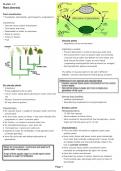Summary
Summary plant diversity grade 11 (ieb)
- Course
- Institution
- Book
Summary of biology ieb grade 11 plant diversity. The notes are informative and detailed and include pictures and diagrams. The notes are mainly comprised of the textbook as well as my own notes from class.
[Show more]




